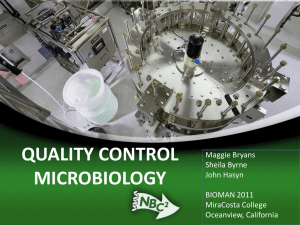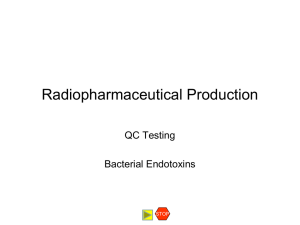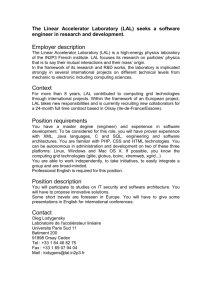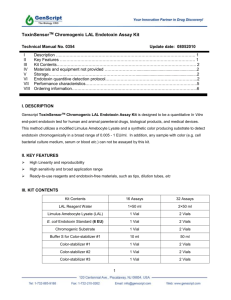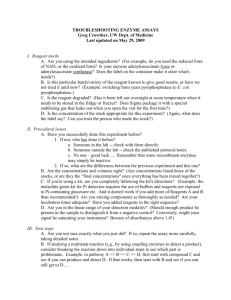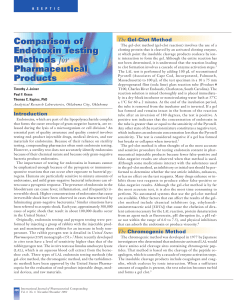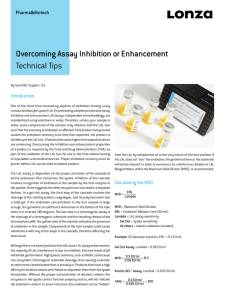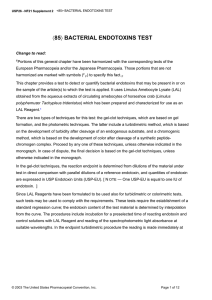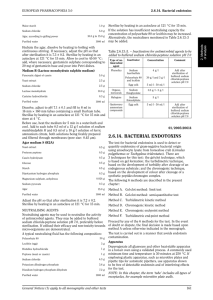GenScript TissueDirect Multiplex PCR System Protocol
advertisement
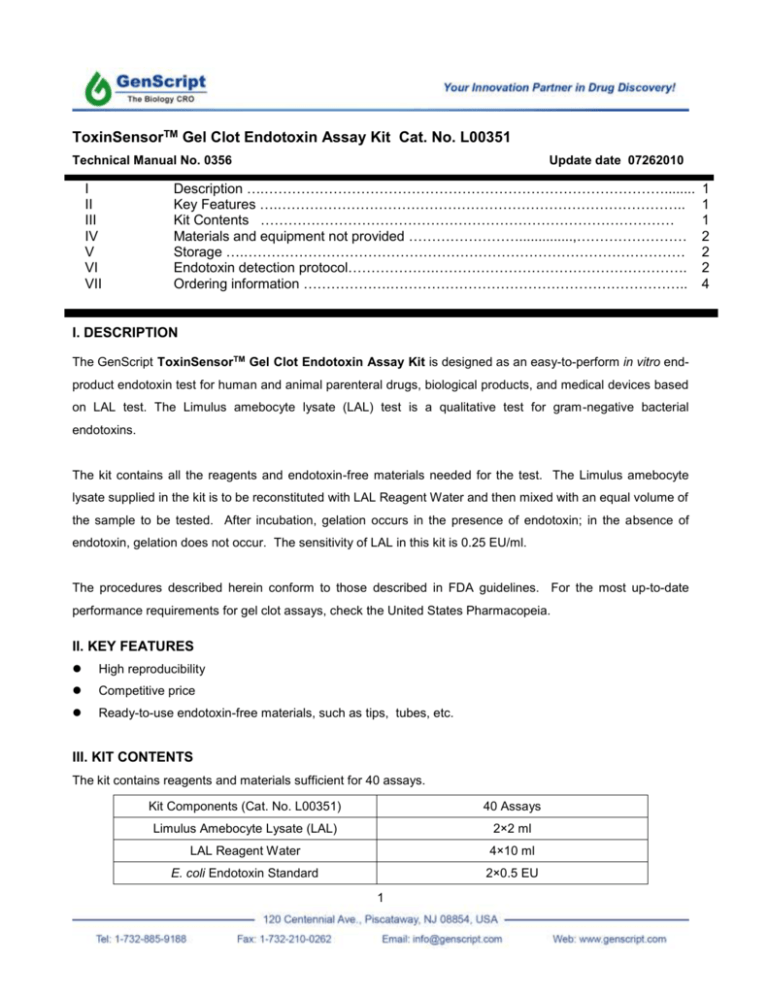
ToxinSensorTM Gel Clot Endotoxin Assay Kit Cat. No. L00351 Technical Manual No. 0356 I II III IV V VI VII Update date 07262010 Description ….……………………………………………………………………………........ Key Features ….…………………………………………………………………………….. Kit Contents ……………………………………………………………………………… Materials and equipment not provided ……………………..............,…………………… Storage ….…………………………………………………………………………………… Endotoxin detection protocol……………….………………………………………………. Ordering information ……………….……………………………………………………….. I. DESCRIPTION The GenScript ToxinSensorTM Gel Clot Endotoxin Assay Kit is designed as an easy-to-perform in vitro endproduct endotoxin test for human and animal parenteral drugs, biological products, and medical devices based on LAL test. The Limulus amebocyte lysate (LAL) test is a qualitative test for gram-negative bacterial endotoxins. The kit contains all the reagents and endotoxin-free materials needed for the test. The Limulus amebocyte lysate supplied in the kit is to be reconstituted with LAL Reagent Water and then mixed with an equal volume of the sample to be tested. After incubation, gelation occurs in the presence of endotoxin; in the absence of endotoxin, gelation does not occur. The sensitivity of LAL in this kit is 0.25 EU/ml. The procedures described herein conform to those described in FDA guidelines. For the most up-to-date performance requirements for gel clot assays, check the United States Pharmacopeia. II. KEY FEATURES High reproducibility Competitive price Ready-to-use endotoxin-free materials, such as tips, tubes, etc. III. KIT CONTENTS The kit contains reagents and materials sufficient for 40 assays. Kit Components (Cat. No. L00351) 40 Assays Limulus Amebocyte Lysate (LAL) 2×2 ml LAL Reagent Water 4×10 ml E. coli Endotoxin Standard 2×0.5 EU 1 1 1 1 2 2 2 4 Endotoxin-free vials 5×16 Tips 200 μl 1 box Tips 1000 μl 2 bags Incubation Rack 1 IV. MATERIALS AND EQUIPMENT NOT PROVIDED 1. Sodium hydroxide, 0.1N, or hydrochloric acid, 0.1N dissolved in LAL Reagent Water, for pH adjustment of samples when necessary 2. Oven or non-circulating hot water bath (37 ± 1°C) 3. Test tube rack. 4. Vortex Mixer. V. STORAGE The kit should be stored dry at room temperature for up to one month. For longer storage, the kit can be kept at 2–8°C for up to one year. Do not freeze the kit or any of its components. VI. ENDOTOXIN DETECTION PROTOCOL 1. Reagent preparation Limulus Amebocyte Lysate (LAL). Reconstitute the lysate just before use. Reconstitute lyophilized lysate by adding 2 ml LAL reagent water to the tube. Swirl gently but thoroughly for at least 30 seconds. Do not shake or vortex to avoid foaming. Reconstituted lysate can be stored at -20°C or colder for up to one week if frozen immediately after reconstitution. Thaw and use only once. Positive controls Reconstitute E. coli endotoxin Standard to 0.5 EU/ml by adding 1 ml LAL reagent water to the tube. Vortex the vial of endotoxin for at least 15 minutes to allow it solubilize thoroughly. Reconstituted E. coli endotoxin can be stored at -20°C or colder for up to 15 days. Samples 1. pH: The endotoxin detection assays are optimized to work with samples with a pH range of 6 - 8. If the pH of the sample falls outside of this range, it should be adjusted with a buffer or HCl or NaOH. Make sure the buffer is endotoxin free. 2. Dilution: Most samples need to be diluted with LAL reagent water before they are tested with one of our endotoxin detection kits. In order to determine how far out you should dilute your sample, you should calculate 2 the MVD (Maximum Valid Dilution) for the sample. The MVD of a sample is its endotoxin limit in EU/ml divided by lambda. Lambda is the sensitivity of LAL, 0.25 EU/ml in this kit. Note: It is not recommended to use this kit to detect contamination by Beta Glucans. This contaminant can come from yeast and cellulosic materials. 2. Test procedure Each assay should include both a positive control and a negative control. LAL Reagent Water can be used as a negative control. (1). Carefully dispense 0.1 ml of LAL solution into the Endotoxin-free vials. Label them as negative control, positive control, and samples. (2). Carefully transfer 0.1 ml of positive control, negative control and the test samples to the LAL reagent in step (1). Cap the vials and mix them thoroughly. (3). Place all the vials in the incubation rack and incubate the vials by placing the rack in a 37°C non-circulating hot water or Oven. (4). Remove the rack after 60 minutes (± 2 minutes) of incubation, invert each vial and check whether a gel is formed or not. a) A positive reaction is characterized by the formation of a firm gel that remains intact when the vial is inverted. b) A negative reaction is characterized by the absence of a solid clot. The lysate may show an increased turbidity or viscosity. This is considered a negative result. (5). Calculation of endotoxin level. In this test, the endotoxin level in the positive sample is equal to or higher than 0.25 EU/ml; while in the negative sample lower than 0.25. 3. Application Example 1. Sample: Protein A, 1 mg/ml in PBS, pH 7.4. It is purified from E. coli sonicate by Ni-NTA Resin. 2. Dilution by LAL Water: 1: 200,000, 1: 400,000, 1: 800,000 3. The test is performed as described above and the assay result is: Positive control + Negative control - 1: 200,000 + 1: 400,000 - 1: 800,000 - 4. Endotoxin concentration in this sample is: from 200,000×0.25 to 400,000×0.25, that is, from 50,000 to 100,000 EU/ml. 3 VII. ORDERING INFORMATION Product Name Cat. No. ToxinSensorTM Chromogenic LAL Endotoxin Assay Kit L00350-32 rxns ToxinSensorTM Chromogenic LAL Endotoxin Assay Kit L00350C-16 rxns ToxinSensorTM Gel Clot Endotoxin Assay kit ToxinEraserTM Endotoxin Removal kit GenScript USA Inc. 120 Centennial Ave., Piscataway, NJ 08854 Tel: 732-885-9188, 732-885-9688 Fax: 732-210-0262, 732-885-5878 E-mail: info@genscript.com Web: http://www.Genscript.com For In Vitro Research Use Only. 4 L00351 L00338
